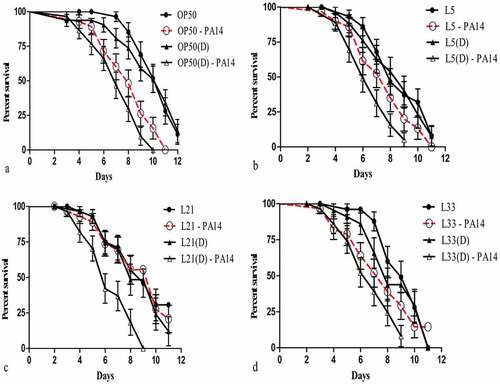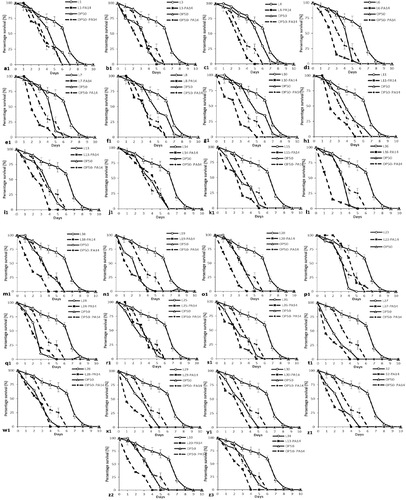Figures & data
Table 1. Bacterial strains used in this study All 35 LAB (lactic acid bacterial) strains were isolated from Korean fermented soybean paste.
Table 2. Acid resistance of lactic acid bacteria in phosphate-saline buffer (pH 2.5). Values are expressed in mean ± standard deviation (n = 3) Different superscripts (a, b, c, d, e, f, g, h, i, j, k, l, m, n, o, p, q, r, s, t, u) represent significantly different values (P < 0.05) .
Table 3. Probiotic characteristics of the selected Lactic acid bacterial strain.
Figure 1. (a) Selection of preferred LAB among 35 strains (either broth or cell pellet) as food to C. elegans. (a) Cell pellet of LAB strains collected by micro-centrifuge and used as bacterial food in NGM plates with worms (n = 150 per plate). From chemotaxis assay results, worms showed a high preference for 4 LAB strains and low preference for 31 LAB strains compared with solvent (butanol and octanol). (b) Chemotaxis assay Broth of LAB strains used as food in NGM plates with worms (n = 150 per plate). A total of Worms showed high preference for 33 LAB strains and low preference for 2 LAB (L1 and L2) strains. Preference was obtained from the choice index as a numerical value (Y axis) and the threshold value from bacterial strains as the horizontal axis (X axis). (c) Fertility in C. elegans fed on various lactic acid bacteria. To explore effects of lactic acid bacteria on the fertility of nematodes, we used lactic acid bacteria as food instead of E. coli OP50 normally used in experimental conditions. The results indicate that worms fed LAB (L01-L35) had low reproduction and developmental rates compared with worms fed control E. coli OP50.
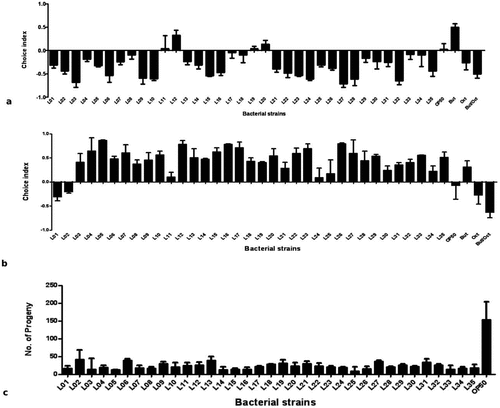
Figure 2. Life span and killing of C. elegans fed on various lactic acid bacteria and pathogens. (a)E. coli OP50 as their basic food for 24 h in NGM plates and then transferred onto P. aeruginosa (PA14)-seeded NGM plates, and the number of dead worms was enumerated each day until the 8th day of incubation. (b-j) Initially, the worms were fed for 24 h with lactic acid bacteria, which were seeded on NGM plates, and later, the worms were transferred onto PA14-seeded NGM plates (b) L2: Enterococcus faecium SC54, (c) L5: Lactobacillus brevis SDL1411, (d) L9: Lactobacillus plantatrum JDFM44, (e) L12: Leuconostoc citreum SC53, (f) L17: Pediococcus acidilatic SDL1414, (g) L21: Pediococcus acidilatici DM-9, (h) L22: Pediococcus pentosaceus MAC-11, (i) L31: Weissella koreensis JBNU2, and (j) L33: P. pentosaceus SDL 1409. In each experiment, 30 worms were administered, repeated twice and plotted using OASIS II. (a1-z2) Initially, the worms were fed for 24 h with lactic acid bacteria, which were seeded on NGM plates, and later, the worms were transferred onto PA14-seeded NGM plates (a1) L1: Enterococcus faecalis SC54, (b1) L3: Enterococcus faecium CK-5, (c1) L4: Enterococcus lactis SCL1421, (d1) L6: Enterococcus lactis SCL1421, (e1) L7: Lactobacillus curvatus JBNU38, (f1) L8: Lactobacillus pentosus SC48, (g1) L10: Lactobacillus rhamnosus JDFM33, (h1) L11: Lactobacillus rhamnosus JDFM6, (i1) L13: Leuconstoc mesenteroides JBNU10, (j1) L14: Leuconstoc paramesenteroides SC46, (k1) L15: Pediococcus acidilatic SCL1420 (l1) l16: Pediococcus acidilatic SKL1418, (m1) L18: Pediococcus acidilatic SDL1406, (n1) L19: Pediococcus acidilatic SDL1405, (o1) L20: Pediococcus acidilatic SDL1402, (p1) L23: Pediococcus pentosaceusSDL1416, (q1) L24: Pediococcus pentosaceus SDL1415, (r1) L25: Pediococcus pentosaceus SDL1401, s1) L26: Streptococcus thermophiles SCML337, (t1) L27: Streptococcus thermophiles SCML300, (w1) L28: Weissella cibaria SCCB2306, (x1) L29: Weissella cibaria SCCB2320, (y1) L30: Weissella confusa SCKB2318, (z1) L32 Weissella cibariaSCCB2307 and (z2) L34: Lactobacillus plantatrum SDL1413, (z2) L35: Lactobacillus arizonensis SC25. In each experiment, 30 worms were administered, repeated twice and plotted using OASIS II.
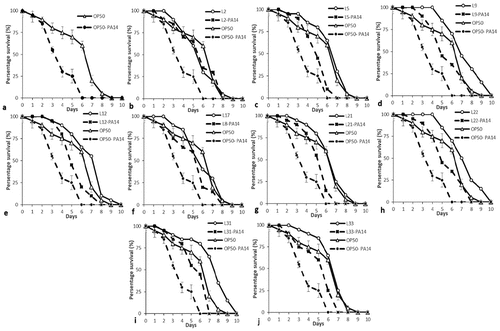
Figure 3. Bacterial colonization in C. elegans. Evaluation of LAB colonization (numbers of log CFU/nematode) in the nematode intestine. (a, b, c) Representation of pre-exposure to LAB or P. aeruginosa PA14. The habituation of LAB in the worm showed a minor degree of inhibition with the increase in the number of P. aeruginosa PA14 in the intestine of nematodes at the seventh and ninth days of incubation. (a) L5: Lactobacillus brevis SDL 1411 (b) L21: Pediococcus acidilatici DM – 9 (c) L33: Pediococcus pentosaceus SDL 1409. All results are presented as the means± standard error mean.
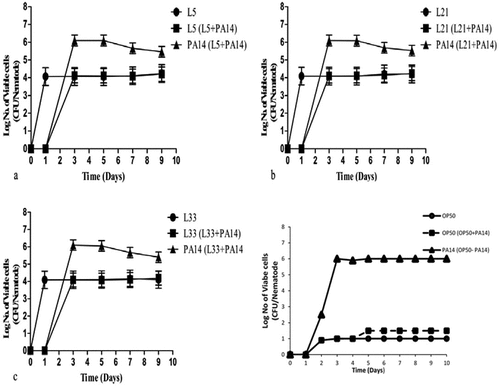
Figure 4. Lifespan and killing of C. elegans fed on heat-killed lactic acid bacteria and pathogens. (a) Young adult stage worms were transferred onto PA14-seeded NGM plates after 24 h incubation, and later, the worms were transferred onto E. coli OP50-seeded NGM plates; the dead worms were enumerated each day until the 8th day of incubation. (D): Worms were transferred onto PA14-seeded NGM plates, which were pre-exposed with heat-killed E. coli OP50 for 24 h on NGM plates; later, the dead worms were enumerated each day until the eighth day. (B-H) Lactic acid bacteria-seeded NGM plates and PA14-seeded NGM plates after 1-day incubation on LAB-seeded NGM plates. (b) L5: Lactobacillus brevis SDL 1411, (c) L21: Pediococcus acidilatici DM – 9, (d) L33: Pediococcus pentosaceus SDL 1409. Each experiment administered 30 worms and was repeated twice, and the results were plotted using OASIS II program. (Each experiment groups labelled “D” – heat-killed bacteria in experiment).
